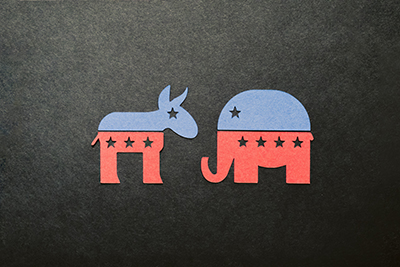New IPR Research: January 2023
Get all our news

This month’s new research from IPR faculty examines the connection between eviction rates and adverse pregnancy outcomes, the association between childhood risk and cardiovascular risk, and racial disparities in sleep. It also investigates gender and bureaucratic corruption, interventions to reduce partisan animosity, and the role of empathy in changing health behaviors.
Social Disparities and Health
Evictions Rates and Adverse Pregnancy Outcomes
Housing instability, especially eviction, can have a negative impact on pregnancy outcomes due to financial, social, and emotional stress. Former IPR post-doctoral fellow Alexa Freedman, IPR health psychologist Greg Miller, professor of obstetrics and gynecology and IPR associate Ann Borders, and their colleagues investigate the connection between neighborhood eviction rates and adverse pregnancy outcomes in a study published in the Journal of Epidemiology and Community Health. The researchers looked at delivery records from 76,938 single births between March 2008 and March 2018 at a Chicago hospital. They used addresses of individuals to identify neighborhoods, and determined the eviction rates of those neighborhoods using data from Princeton University’s Eviction Lab. The study finds that mothers who lived in neighborhoods with the highest eviction rates were 1.17 times as likely to deliver their babies pre-term and were 1.13 times more likely to deliver a baby with low birth weight compared to those living in neighborhoods with the lowest eviction rates. These results suggest that mothers living in neighborhoods with higher eviction rates are more likely to deliver pre-term. The connection was strongest for individuals with a lower median household income. The researchers argue that it is important to be aware of the connection between eviction rates and pregnancy outcomes in order to inform policy that could improve tenant protections and living conditions in low-income areas. Miller is the Louis W. Menk Professor of Psychology.
The Association Between Childhood Abuse and Cardiovascular Risk
Experiences early in life such as childhood abuse can potentially lead to increased cardiovascular disease risk factors in adulthood. In the Journal of the American Heart Association, pediatrician and IPR associate Nia Heard-Garris and her colleagues examine the association between exposure to abuse in childhood and four major risk factors for heart disease, including obesity, type 2 diabetes, high blood pressure, and hyperlipidemia, or high cholesterol and other fats in the blood, and whether growing up in a nurturing household affects the relationship. The researchers explored data from the ongoing Coronary Artery Risk Development in Young Adults (CARDIA) study, which follows over 5,000 Black and White adults from four cities who were recruited from 1985–86. Participants, who were aged 33–45, completed a questionnaire about their exposure to physical or psychological abuse and their home environment as a child, which aimed to compare associations between abuse, nurturing relationships, household organization and cardiovascular disease risk factors. The results showed that White men who experienced occasional or frequent childhood abuse had a higher risk of developing type 2 diabetes than those who experienced no abuse. For White men and women, the risk for hyperlipidemia was low for those in a non-abusive household. However, the risk was higher for White women in dysfunctional or abusive households. The patterns remain similar for Black men: Those who experienced occasional or frequent abuse had a lower risk of hyperlipidemia if they lived in a well-managed household. Among differing race, gender, and household organization, abuse in childhood was not associated with an increased risk of the other cardiovascular disease factors, such as obesity and hypertension. These results suggest that there is a connection between childhood abuse and cardiovascular risk factors that differs by race, gender, and household organization. More research is necessary to better understand these differences.
Racial Disparities in Sleep
 Previous research shows racial disparities in sleep, but few studies have examined whether psychological distress is the pathway linking discrimination and rest. Anthropologist and IPR associate Kristen Knutson and Northwestern University postdoctoral fellows Michael Mead and Emily Vargas examine whether experiences of discrimination and psychological distress contribute to racial disparities in sleep in the Journal of Racial and Ethnic Health Disparities. Knutson and her colleagues analyzed data collected in 2010 from the Health Retirement Study, a nationally representative longitudinal aging study. They focused on a group of 7,749 Black and White respondents who filled out a questionnaire asking about everyday discrimination, loneliness, ongoing chronic stressors, depressive symptoms, and self-reported sleep health. On average, participants were 67 years old, and the majority were White (82.9%) and female (58.4%). Black respondents reported higher experiences of discrimination, which in turn was associated with greater psychological distress and linked to poorer sleep quality. The evidence shows that discrimination may be uniquely detrimental to sleep, even after accounting for psychological distress. This study builds on previous research by demonstrating that racial disparities in sleep can be explained by greater experiences of discrimination, contributing to greater psychological distress. The researchers suggest that future research continue to examine how discrimination impacts sleep duration, continuity, and timing, and how psychological distress plays into those relationships.
Previous research shows racial disparities in sleep, but few studies have examined whether psychological distress is the pathway linking discrimination and rest. Anthropologist and IPR associate Kristen Knutson and Northwestern University postdoctoral fellows Michael Mead and Emily Vargas examine whether experiences of discrimination and psychological distress contribute to racial disparities in sleep in the Journal of Racial and Ethnic Health Disparities. Knutson and her colleagues analyzed data collected in 2010 from the Health Retirement Study, a nationally representative longitudinal aging study. They focused on a group of 7,749 Black and White respondents who filled out a questionnaire asking about everyday discrimination, loneliness, ongoing chronic stressors, depressive symptoms, and self-reported sleep health. On average, participants were 67 years old, and the majority were White (82.9%) and female (58.4%). Black respondents reported higher experiences of discrimination, which in turn was associated with greater psychological distress and linked to poorer sleep quality. The evidence shows that discrimination may be uniquely detrimental to sleep, even after accounting for psychological distress. This study builds on previous research by demonstrating that racial disparities in sleep can be explained by greater experiences of discrimination, contributing to greater psychological distress. The researchers suggest that future research continue to examine how discrimination impacts sleep duration, continuity, and timing, and how psychological distress plays into those relationships.
Politics, Institutions, and Public Policy
Gender and Bureaucratic Corruption
While research exists comparing the different ways men and women govern, a related question is which gender is more corrupt when holding positions of public office. In the Journal of Law, Economics, and Organization, IPR economist Silvia Vannutelli and her colleagues examine the connection between gender and bureaucratic corruption among elected officials in Italy and China. The researchers examine a dataset of Italian officials who presided over at least one procurement auction between 2000 and 2016 with the value of at least €40,000. They also analyzed a dataset of all Chinese bureaucrats who held the position of prefecture mayor or party secretary between 1979 and 2014. The researchers then compared the datasets to Italian and Chinese datasets of officials investigated for corruption. In both countries, women were less likely to be investigated for corruption compared to men. The Italian female officials were 22% less likely to be investigated for corruption and Chinese female officials were 81% less likely to have been arrested for corruption compared to male. The researchers also analyzed survey data of Italian officials collected by other researchers in 2020 to understand why women face fewer investigations and find that women followed more strict legal protocols than their male counterparts. The researchers speculate that women may face more leniency from law enforcement or that men may have more opportunities to commit corruption, but they suggest that future research investigate the gender difference further.
Interventions to Reduce Partisan Animosity
 Partisan animosity is rising in the United States, which may reduce support for democracy, strain social connections, and undermine policymaking. In Nature Human Behavior, social psychologist and IPR associate Eli Finkel and his colleagues review interventions to reduce partisan animosity, using the TRI framework, a term they coin to capture three levels of interventions: thoughts, relationships, and institutions. They examine interventions in thoughts (correcting misperceptions and highlighting commonalities), relationships (building dialogue skills and fostering positive contact), and institutions (changing public discourse and transforming political structures), highlighting real interventions conducted by nonprofits. For example, they point to Public Agenda’s “Hidden Common Ground” initiative, a large-scale initiative which seeks to help Americans recognize commonalities they share through research, journalism, and public engagement. To foster positive contact between partisans, the organization Braver Angels hosts discussions between people of different political backgrounds, focusing on policy issues they have in common. To make real change on a large scale, the researchers argue that practitioners must motivate people to form relationships with those from the other party and mobilize Americans to push for institutional change, such as changing the public discourse. The researchers suggest that to create more effective interventions to reduce partisan animosity, future research consider four issues: variation, replicability, scope, and interdisciplinarity.
Partisan animosity is rising in the United States, which may reduce support for democracy, strain social connections, and undermine policymaking. In Nature Human Behavior, social psychologist and IPR associate Eli Finkel and his colleagues review interventions to reduce partisan animosity, using the TRI framework, a term they coin to capture three levels of interventions: thoughts, relationships, and institutions. They examine interventions in thoughts (correcting misperceptions and highlighting commonalities), relationships (building dialogue skills and fostering positive contact), and institutions (changing public discourse and transforming political structures), highlighting real interventions conducted by nonprofits. For example, they point to Public Agenda’s “Hidden Common Ground” initiative, a large-scale initiative which seeks to help Americans recognize commonalities they share through research, journalism, and public engagement. To foster positive contact between partisans, the organization Braver Angels hosts discussions between people of different political backgrounds, focusing on policy issues they have in common. To make real change on a large scale, the researchers argue that practitioners must motivate people to form relationships with those from the other party and mobilize Americans to push for institutional change, such as changing the public discourse. The researchers suggest that to create more effective interventions to reduce partisan animosity, future research consider four issues: variation, replicability, scope, and interdisciplinarity.
Child, Adolescent, & Family Studies
The Role of Empathy in Chinese Adolescences' Preventative Health Behavior During COVID-19
Previous research has shown that empathy can be an effective tool at encouraging adolescents to assist others and act for the good of society. In the Journal of Adolescent Health, developmental psychologist and IPR associate Yang Qu and his colleagues explore the role of empathy in adolescents’ preventive health behaviors during the COVID-19 pandemic. The researchers asked 442 Chinese seventh graders, who were on average 13 years old, to complete two surveys in July and September 2020. In the first survey, they reported their empathic concern and perspective taking by answering questions such as “I am often quite touched by things that I see happen” and “I sometimes try to understand my friends better by imagining how things look from their perspective,” along with their concern for their personal health. In both the first and second survey, the adolescents reported their preventive health behavior (e.g., practicing social distance and wearing a mask when going outside) and COVID-related worry. The results reveal that adolescents who reported greater empathetic concern in the first survey were more worried about COVID-19 and engaged in more preventive health behavior. This suggests that higher levels of empathic concern in adolescents were predictive of more frequent preventive health behavior motivated by their desire to help others. Future studies looking at the connection between empathy and health behaviors can examine participants over longer periods and explore how other factors may influence behavior.
Photo credits: Pexels and Unsplash
Published: January 23, 2023.


